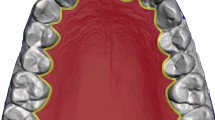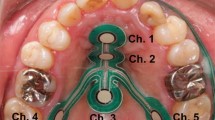Abstract
This article introduces a new way of recording intraoral pressures from a range of locations within the oral cavity. To measure pressure flow dynamics during swallowing, we fitted eight miniature pressure transducers capable of measuring absolute pressures to a chrome-cobalt palatal appliance with a labial bow. Unlike previous devices, our design provides a rigid, custom-fitted platform for the simultaneous recording of pressures at eight locations within the oral cavity during function. We placed an anterior pair of gauges to measure lingual and labial contact against the left central incisor tooth, and two pairs of gauges to measure pressure contributions of the lateral tongue margin and cheeks on the canine and first molar teeth. Finally, lingual pressure on the midline of the palate was measured by two gauges, one at the position of the premolars and one on the posterior boundary of the hard palate. We then recorded intraoral pressures in five adult volunteers seated in an upright position and asked to swallow 10 ml of water. Labial pressures on the canine rose rapidly from a resting level of 10 kPa to 33 kPa, while pressure profiles from the labial aspects of the incisor and first molar teeth followed a negative pattern, peaking at −12 kPa for the incisor and −15 kPa for the molar sensor. Pressure profiles recorded from the palatal aspects of the first molar and the canine appeared to be similar, but the former fell to −13 kPa before rising to 9 kPa, and the canine pressure rapidly increased to 22 kPa before returning to its resting level of 4 kPa. The pressure profile of the palatal aspect of the central incisor was strikingly different; at the start of the swallow, pressure dropped precipitously to −20 kPa, before slowly rising to 10 kPa. It then followed the general pattern of the other two sensors, before peaking again at 10 kPa and then returning to a resting level of 4 kPa. We also showed that there were significant negative pressures in the mouth during function, and that pressure profiles varied markedly between individuals.





Similar content being viewed by others
References
Stetson RH. Motor phonetics. Arch Neerl Phon Exp 1928;3:5–216.
Stevens HM. The intraoral pressures exerted on maxillary and mandibular central incisors by the tongue and lips in Angle class II division I cases. Am J Orthod 1956;42:937.
Kydd WL. Quantitative analysis of forces of the tongue. J Dent Res 1956;35:171–174.
Kydd WL. Maximum forces exerted on the dentition by the perioral and lingual musculature. J Am Dent Assoc 1957;55:646–651.
Alderisio JP, Lahr R. An electronic technique for recording the hypodynamic forces of lip, cheek and tongue. J Dent Res 1953;32:548–553.
Gould MSE, Picton DCA. A method for measuring forces acting on the teeth from the lips, cheeks and tongue. Br Dent J 1962;112:235–242.
Gould MSE, Picton DCA. An evaluation of a method for measuring forces exerted by the tongue on the teeth. Br Dent J 1963;114:175–180.
Proffit WR. Muscle pressures and tooth position: North American Whites and Australian Aborigines. Angle Orthod 1975;45:1–11.
Proffit WR, Kydd WL, Wilskie GH, Taylor DT. Intraoral pressure in a young adult group. J Dent Res 1964;43:555–562.
Thuer U, Ingervall B. Pressure from lips on teeth and malocclusion. Am J Orthod Dentofac Orthop 1986;90:234–242.
Thuer U, Grunder J, Ingervall B. Pressure from the lips on the teeth during speech. Angle Orthod 1999;69:133–141.
Lindeman DE, Moore RN. Measurement of intraoral muscle forces during functional exercises. Am J Orthod Dentofacial Orthop 1990;97:289–300.
Frohlich K, Ingervall B, Schmoker R. Influence of surgical tongue reduction on pressure from the tongue on the teeth. Angle Orthod 1993;63:191–198.
Fletcher SG, Dagenais PA, Critz-Crosby P. Teaching consonants to profoundly hearing-impaired speakers using palatometry. J Speech Hear Res 1991;34:929–942.
Dromey C, Nissen S, Nohr P, Fletcher SG. Measuring tongue movements during speech: Adaptation of a magnetic jaw-tracking system. Speech Commun 2006;48:463–373.
Ono T, Hori K, Nokubi T. Pattern of tongue pressure on hard palate during swallowing. Dysphagia 2004;19:259–264.
Hind JA, Nicosia MA, Gangnon R, Robbins JA. The effects of intraoral pressure sensors on normal young and old swallowing patterns. Dysphagia 2005;20:249–253.
McNulty EC, Lear CSC, Moorrees CFA. Variability in lip adaptation to changes in incisor position. J Dent Res 1968;47:537–547.
Shellhart WC, Moawad MI, Matheny J, Paterson RL, Hicks EP. A prospective study of lip adaptation during six months of simulated mandibular arch expansion. Angle Orthod 1997;67:47–54.
Thuer U, Sieber R, Ingervall B. Cheek and tongue pressures in the molar areas and atmospheric pressure in the palatal vault in young adults. Eur J Orthod 1999;21:299–309.
Frohlich K, Thuer U, Ingervall B. Pressure from the tongue on the teeth in young adults. Angle Orthod 1990;61:17–23.
Ruan W, Chen M, Gu Z, Lu Y, Guo Q. Muscular forces exerted on the normal deciduous dentition. Angle Orthod 2005;75:785–790.
Hori K, Ono T, Nokubi T. Coordination of tongue pressure and jaw movement in mastication. J Dent Res 2006;85:187–191.
Acknowledgments
The authors gratefully acknowledge financial assistance from the New Zealand Dental Association Research Foundation, a University of Otago Research Grant, and seeding money from Joe Kieser.
Author information
Authors and Affiliations
Corresponding author
Rights and permissions
About this article
Cite this article
Kieser, J., Singh, B., Swain, M. et al. Measuring Intraoral Pressure: Adaptation of a Dental Appliance Allows Measurement During Function. Dysphagia 23, 237–243 (2008). https://doi.org/10.1007/s00455-007-9126-z
Received:
Accepted:
Published:
Issue Date:
DOI: https://doi.org/10.1007/s00455-007-9126-z




